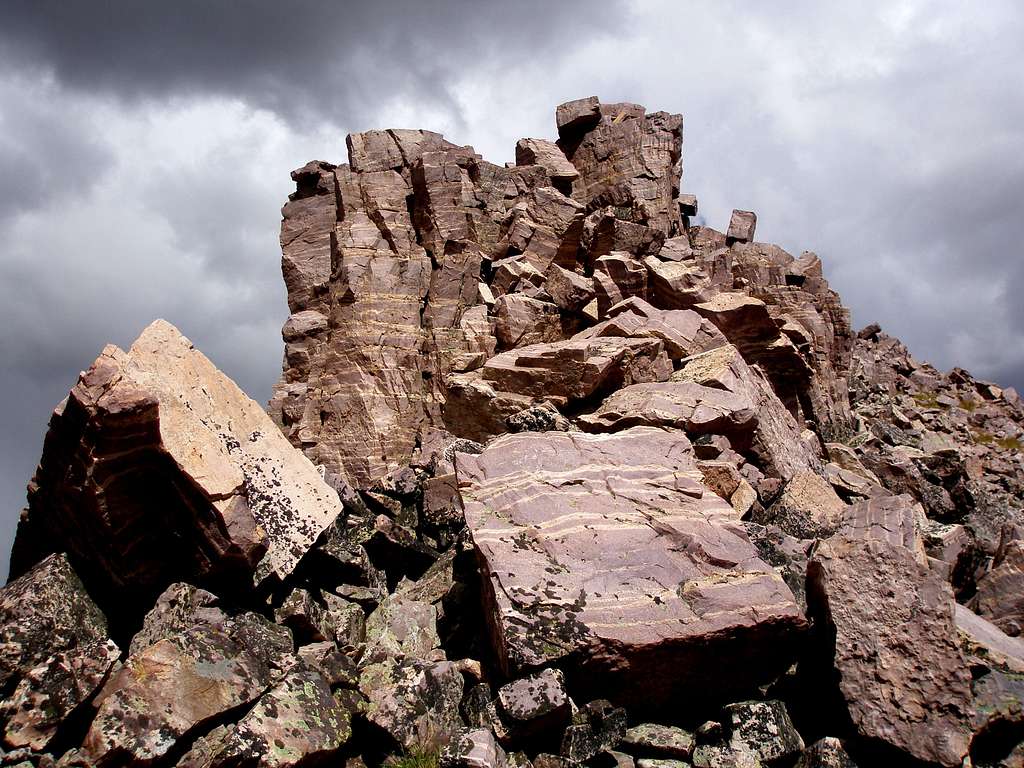lcarreau - Oct 28, 2009 1:20 pm - Voted 10/10
Not quartzite ...The "banding" in the rock suggests this is
shale. The layers accumulated as mud, and were pushed upward by the Laramide Orogeny.
I still don't know where the "reds" came from
that we're seeing in the quartzites.
Being that quartszite is "metamorphic sandstone," we can only surmise that
oxidation has created the red colors that
are visible in your awesome photographs.
Fred Spicker - Oct 28, 2009 4:51 pm - Hasn't voted
Re: Not quartzite ...I disagree - this rock has all the appearance of being quartzite. The way it breaks is quite distinctive. It is certainly not shale. Shale would break into thin layers.
The banding is probably due to layers of slightly different compositions within the original sand deposit and / or a migration and accumulation of like minerals into bands during metamorphosis (while under extreme pressure and heat).
The red color could come from oxidation as you suggest, or the original sand could have had a reddish color to start with.
Bill Kerr - Oct 28, 2009 5:18 pm - Voted 10/10
Definitely quartzite ...Have to agree with Fred on this one. Quite common for the bedding in the original sand or siltstone to show in the quartzite. The surface appearance is grains melted together and the blocky breakage pattern say quartzite. The white layers are cleaner sands(white quartz) and the red layers are siltier or red clays/muds with iron and feldspars mixed with the quartz sand.
ZeeJay - Oct 28, 2009 7:09 pm - Hasn't voted
Re: Definitely quartzite ...Thanks El, Fred, and Bill. Whatever it is, it's cool looking. This was the only instance of striped rock I noticed on that particular trip, but about 6 miles east there's quite a lot of it, some of it being fairly large standalone boulders.
lcarreau - Oct 28, 2009 9:47 pm - Voted 10/10
Re: Definitely quartzite ...Blushing ... geology was never one of my stronger suits.
I've always been a "Jack of Spades" man !!! :))
... or Captain Jack, now that it's so close
to the bewitching hour of Halloween.
Scott - Oct 28, 2009 11:59 pm - Hasn't voted
Uinta Mountain GroupIf interested.......
More specificially, this is the Uinta Mountain Group which is made up of pre-cambrian quartzite. With the exception of Red Castle, which actually does have shale all of the core of the High Uintas is made of quartzite.
Other than the Red Castle and Uinta Mountain Group, only the outer fringes and lower elevations of the Uintas contain other types of rocks (all of which are much younger. Limestones, sandstones and shales are all common in the foothills and lower elevations of the Uintas, but other than some of the rocks on Red Castle, never up high.










Comments
Post a Comment